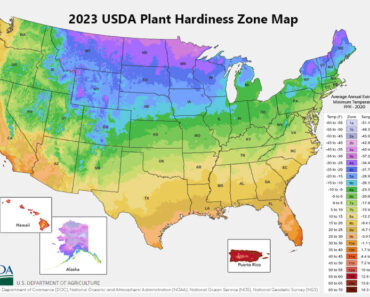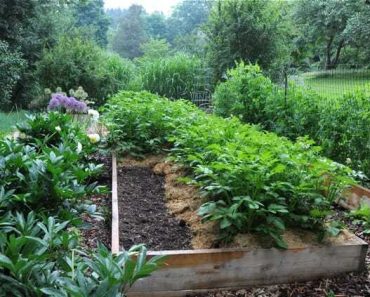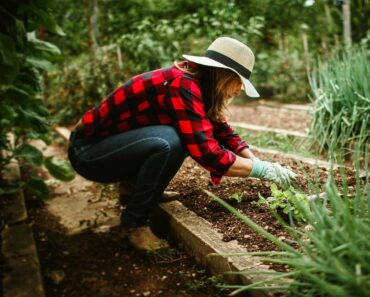
MY FIRST EXPLORATION INTO growing garlic was also my first encounter with Filaree Farm. I hate to confess how long it has been since I first read “Growing Great Garlic,” the popular book by Filaree’s founding farmer, Ron Engeland (hint: publication date, 1991). Today, it’s Alley Swiss who farms the venerable Filaree acreage in Okanogan, Washington, where organically grown seed garlic has been produced for nearly 30 years.
In between his daunting chore list—Alley harvests more than 20,000 pounds of Allium sativum a season, representing a staggering 100-plus varieties from around the world—he made time to answer all my garlic-growing questions, from the best varieties for various regions, tastes from hot to mild, and more.
my q&a with alley swiss
Q. In my Zone 5B Northeastern location, I have done very well with hardneck varieties [detail above, and growing in my raised beds, top photo]. As a seller of garlic to customers all over the U.S., can you suggest the best variety choices for different regions?
A. Many people don’t know that they can grow garlic where they live. At Filaree Farm, we have heard from customers who have grown both hardneck and softneck varieties in every state, including Hawaii and Alaska.
To clarify, garlic varieties are often divided into either softneck or hardneck, with different varietal groupings within those two categories that share common traits. The key difference is that hardneck varieties send up a seed stalk (or scape–which is edible) from the center of the bulb that should be cut, whereas softneck varieties do not have a seed stalk. I suggest these varieties for the following regions:
- Northeast: Both softneck and hardneck varieties do well in the Northeast. ‘Polish White’ is in the Artichoke group and produces large bulbs with very good flavor. Hardneck varieties in the Porcelain group also are favorites with Northeast growers such as ‘German White’ or ‘Romanian Red,’ which have huge cloves and great flavor.
- Southeast: The Turban group (below, drying) includes many beautiful varieties that do well in warm climates. For those who live in the sub-tropical coastal areas in this region, varieties in the Artichoke garlic and Turban groups are the best bet.
- Southwest: The creole variety ‘Ajo Rojo’ is well suited to the hot and arid regions of the country. A Silverskin type named ‘Mild French’ is also a top recommendation.
- Midwest and Northwest central: Varieties that survive harsh winters and hot summers do well in this region. Rocambole and Purple Stripe varieties are good options.
- Northwest and Pacific Coast: A wide range of varieties perform well on the west coast. Purple stripes such as ‘Chesnok Red’ are commonly grown as well as the Silverskin variety ‘Nootka Rose,’ which does well along the rainy NW coast.
Q. What if my soil is sandy (or clayey, or wet, or otherwise tricky)? Can you suggest the best varieties for my conditions?
A. Garlic does prefer a well-drained soil. Amending your soil structure or planting into raised beds is a good idea for poorly draining soil types. The Artichoke garlic varieties are the most adaptable and easiest to grow in a variety of soil types and climates. We do have some varieties that are well adapted to certain conditions; ‘Killarney Red,’ a hardneck type, does quite well in wet and clay soils. Porcelain varieties are such vigorous plants that they do better than others with tight soils and wet conditions, just harvest them a little bit early to avoid deteriorated bulb wrappers.
Q. It’s almost garlic-planting time here. But when should gardeners plant in different regions—and what’s the best practice for bed preparation, planting, mulching, fertilizing?
A. The ideal time for planting garlic is three to five weeks before your ground freezes hard. If you are located in a southern region where the soil does not freeze you’ll want to plant late in November or December. Garlic prefers a well-worked soil with good drainage and lots of organic matter. Don’t fear if your soil type is not perfect; garlic is a tough plant that can adjust to many soil types.
Garlic is a fairly heavy feeder that wants a good amount of Nitrogen available. We recommend spreading an organic fertilizer or composted manure in the area where you will plant and mixing it into the soil well.
After you ‘”pop” your seed by separating the bulb into individual cloves, plant the cloves about 2-3 inches deep with about 5-8 inches between each clove. Water deeply so that there is plenty of moisture for the cloves to start their root growth before the ground freezes. In climates with cold winters, mulch with several inches or more of leaves or hay.
Q. A related question: I’m always asked by readers: Can they plant garlic in spring? Are there any zones where spring planting will yield a harvest?
A. We do recommend planting in the fall to those growing garlic in all zones for the best harvests. That said, it is possible to grow beautiful full-sized bulbs of garlic from a spring planting. The key to all successful spring garlic plantings is planting very early in the spring, as soon as the soil and can be worked–or better yet, planting directly into an area of the garden that was worked the previous fall.
Q. I’m also always asked: What about growing garlic from seed? How long does it take if it’s possible, and which kinds do come from seed best if any?
A. Garlic primarily reproduces vegetatively through cloning and will not produce true seed except in rare cases. Even when garlic does produce true seed, the seed is generally sterile. You can grow garlic from bulbils. Bulbils are small clones that appear at the top of the scape (above) of hardneck varieties and sometimes along the neck of softneck varieties. Some varieties have very small bulbils–smaller than a grain of rice–while other varieties produce bulbils that are nearly as big as a normal clove. It often will take two or three years of replanting before reaching a normal bulb size. We recommend saving bulbils from the Artichoke, Rocambole and Asiatic varieties since they are the largest.
Q. What if I don’t have much space—can I grow garlic in containers (and if so in which hardiness Zones)?
A. We have found that many urban gardeners or those who prefer the ease of container gardening have begun growing garlic on back porches and patios. It is important to find a deep container that has good drainage for growing garlic. Zone 5b or warmer is preferred, but it can be done by insulating the container with mulch in colder climates.
Q. I store a portion of my crop as peeled, whole cloves in the freezer, so it doesn’t deteriorate in my cellar before I get to use it all, but I wish I could get it to last even longer “fresh.” What are the “ideal” conditions for storing garlic?
A. Between 40-55 degrees is optimal with 60-70 percent humidity. If it is too humid you might have problems with mold, and very dry air will dehydrate garlic quicker. You do not want to store garlic in the refrigerator because there is too much moisture. We recommend a root cellar, basement or garage as the best options, but even a cupboard in a cool area of the house will work fine.
Q. Are some varieties better “keepers” that last well in storage all the way to next summer, and the next fresh harvest?
A. Yes! Softneck varieties generally keep the longest, often remaining firm 10 months after harvest. The Artichoke and Silverskin varieties are good choices for long storage. If you prefer hardnecks, some store better than others with Porcelains like ‘Romanian Red’ among the best. Rocamboles have very good flavor but often dehydrate within 3-4 months. In my home we like to eat the shorter-storing varieties first and save mostly Artichoke and Silverskin varieties to eat in the spring and all the way up to the next harvest. “Green” garlic (harvested early, before the bulbs size up) is a fresh treat in the spring if your previous year’s garlic supply is dwindling.
Q. Taste-wise, can you suggest some varieties that are hot or mild, for instance, or are excellent roasted?
A. ‘Silverwhite‘ and ‘Creole Red,’ and ‘Thai Fire’ are some of the hottest varieties we grow. Some of the Artichoke varieties are quite mild, which makes them great for raw use or for those who don’t like a sharp bite; ‘Susanville’ and ‘California Early’ are among the mildest. Purple Stripe varieties are revered by chefs for their sublime sweet flavor when roasted; ‘Metechi’ and ‘Khabar’ are two of the best baking garlics, with a creamy texture when done.
win a copy of ‘growing great garlic’
I’VE BOUGHT THREE COPIES of “Growing Great Garlic,” the book by Filaree Farm‘s founding farmer that got me started growing my favorite allium of all. [UPDATE: The giveaway is over, but your comments continue to be welcome.] To enter to win a copy, all you have to do is comment below, answering this question:
What kind of garlic you grow–hardneck, softneck, or maybe its particular varietal name?
(I’m a hardneck nut, and love ‘German Extra Hardy,’ also called ‘German Stiffneck.’)
Don’t worry if you don’t grow garlic yet, or know the name of the kind you do (or if you feel shy and don’t want to give any details). Just say “count me in” and your entry will be registered.
UPDATE: Winners were chosen at random after entries closed at midnight on Thursday, October 4, 2012.
Ready to grow your own garlic this year? Planting time is just ahead!
(Photos except top two images are copyright Phoebe Webb Photography; used with permission.)





![Georgia’s Farming and Gardening Sector: Top 10 Easiest Veggies to Grow [Infographic] Georgia’s Farming and Gardening Sector: Top 10 Easiest Veggies to Grow [Infographic]](https://sunlitgarden.com/wp-content/uploads/2019/10/variety-of-vegetables-370x297.png)
























